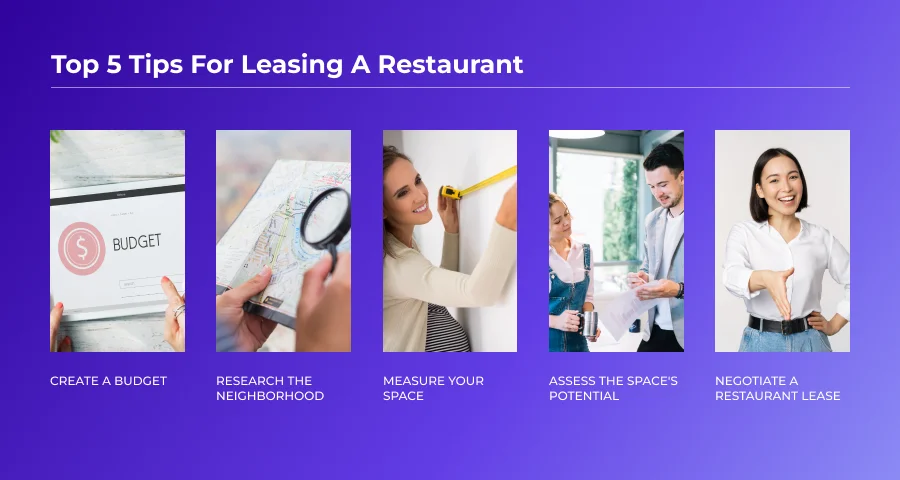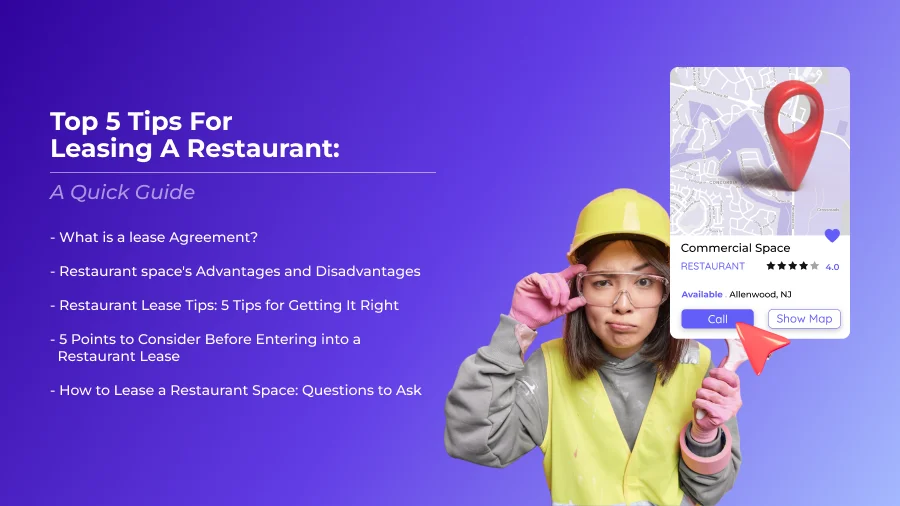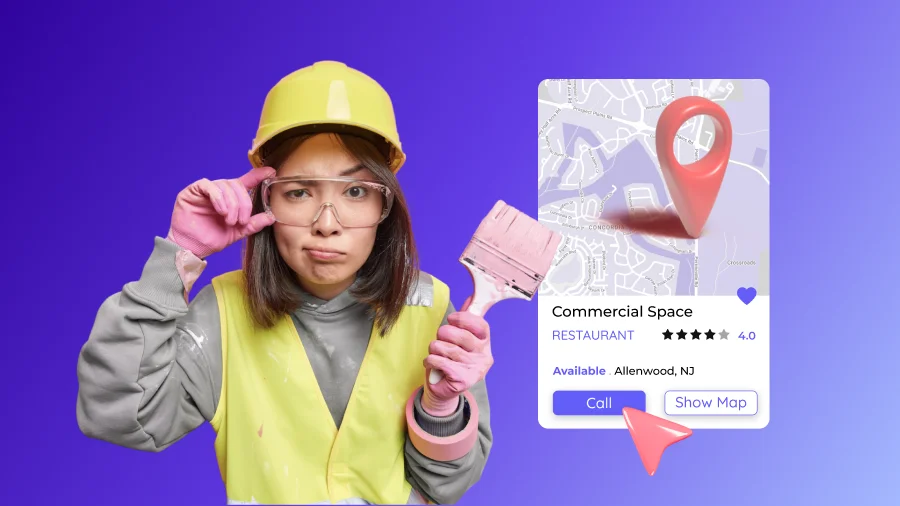Top 5 Tips for Leasing a Restaurant: A Quick Guide
Restaurant leasing is a serious business. In general, restaurant leases last for three to five years, and once you've invested money and time into space, you can't go back. Leasing a restaurant is one of the most important commitments you will make, whether you are an eager new restaurateur or an experienced entrepreneur considering a new location.
Don't sign anything until you have carefully considered your options. To make the process easier for you, here are a few tips:
Commercial lease agreements are legal agreements between landlords and tenants. You must consult a lawyer to understand your relationship with your landlord as a tenant.
While every commercial lease is unique to accommodate the relationship between the tenant and landlord, some facets should be explicitly specified in your agreement.
Restaurant Space's Advantages and Disadvantages
When available, the option to lease or buy commercial property is a rare occurrence.

Advantages
- You'll be putting money into your own space and paying your mortgage rather than someone else's. Mortgage payments are often comparable to monthly rent. A mortgage can also be paid off.
- Property values tend to rise over time. The growth in value may result in a nice payoff if you sell your firm, and the profit here does not even include the increase in the worth of your business itself.
- You will not have to deal with landlords or property managers.
Disadvantages
- You may have to sacrifice location; most popular, high-traffic commercial properties are not for sale.
- You will be responsible for the property's maintenance and repairs as the owner. These expenses pile up and put a strain on your organization if you're not performing well.
- Buying a space requires a lot more startup capital. Considering how expensive it can be to start a restaurant, the average restaurant owner cannot afford to buy a property outright.
Restaurant Lease Tips: 5 Tips for Getting It Right
Once you have a commercial real estate agent on your side, you can begin the hunt for the ideal location. Here are our top five restaurant-finding and leasing tips.
1. Create a Budget
Setting a reasonable budget to work with is vital when assessing different spaces to lease. You won't be able to make decisions or negotiate if you don't have a clear grasp of the prices.
If you have already created a restaurant business plan, you will know how to conduct a market analysis, in which you thoroughly research the market to calculate how much revenue you could potentially bring in.
You look at similar businesses and competitors in the locations where you want to open the restaurant. You can even interview business owners to get a sense of what to expect.
Based on your projected revenue, you can estimate what you can afford to spend on rent, utility bills, insurance, property taxes, and maintenance. In general, restaurateurs budget 5–10% of revenue for these fixed costs. Calculations can be automated with financial spreadsheets.
You can then select how much wiggle space you can leave in your budget based on your capital assets. Keep a buffer in case of unexpected occurrences. Given the past few years, we can all appreciate the necessity of being prepared for a rainy day.

2. Research the Neighborhood
If you're looking at a specific neighborhood, you probably have an idea of the foot traffic and demographics of the individuals who live there. However, when leasing a restaurant for three to five years, it is vital to dive into the facts and plan for the future.
Be patient and don't rush this process. It could take months to thoroughly explore an area and consider all the possibilities.
Is the neighborhood a well-established dining district with a lot of competition, or are you going into an up-and-coming hotspot where you'll have to set the trend and lure consumers to the area? When an area becomes a dining hotspot, restaurant real estate prices can skyrocket.
It's not only about how the neighborhood is right now. You must consider how it will alter during the term of your lease. Consider this: What will the area look like in three years? Are there any emerging trends?
The key factors to dig into include:
a) The competition:
Who are your key competitors? Are there any nearby businesses that will complement your restaurant? A gym, for example, full of fitness enthusiasts could make an excellent neighbor for your smoothie shop.
b) Business turnover:
Do companies come and go in the area, or are there several well-established restaurants? A transient business crowd on a street, building, or even neighborhood is a huge red flag.
c) Foot traffic:
Is there enough foot traffic to support your restaurant? Is it more important that residential areas be closed for delivery orders?
d) Atmosphere:
Make sure you know the region inside and out, at different times of day, and every day of the week. Does it get raucous on Friday nights? Is it a place to spend a lazy Sunday?
e) Access:
Is your space easy to find? Can you provide parking? If not, is it close to public transportation? Consider whether it is simple for your customers to find.
3. Measure your space
Take precise measurements of your possible restaurant space. Agents have been known to overstate or sell “phantom space," which can cause rents to skyrocket. Check that you aren't paying for more space than you need.
Consider how much space you need for the kitchen, bar, and back-of-house areas, as well as how much space you need for dine-in customers (if any). Most restaurants set aside 40% of their budget for service and back-of-house operations.
Naturally, this varies by restaurant, with quick-service restaurants requiring less customer space and fine-dining restaurants requiring up to 20 square feet per seated customer.
4. Assess the Space's Potential
Many restaurateurs want to establish their mark on the restaurant industry, while others want to hit the ground running and start making money right away. As you evaluate your restaurant lease, decide what your key objectives are.
5. Negotiate a Restaurant Lease
It's time to get down to business now that your restaurant finances are in order, you've finished your research, and you've chosen the space that's right for you. But before you sign this vital contract, you must prepare for negotiations.
Here are some great tips to help you overcome your fear and take control of the negotiations while renting a restaurant space.
a) No one is going to negotiate for you
You can be sure that the landlord or agent will work hard to secure the best deal, so you should be prepared to do the same. Don't be afraid to stand up for yourself. Grab your head around your finances, know your budget and how far you're willing to stretch it, and then go out and grab the best deal you can.
b) Be prepared to walk away
This is easier said than done, especially if you've fallen in love with a location and started to fantasize about your future success there. However, if the plan is not suitable for you, it is important to remain rational and free of emotions.
c) Ask more than you need – give wiggle room
Always ask for more than you really want, so there’s room for a little negotiation and compromise. You can be certain that the other party will turn down your first offer.
d) Talk to other tenants
If possible, speak with other tenants in the building to get an idea of how the landlord is. Ask the landlord a lot of questions regarding the reality of leasing.
e) Never accept the first offer
If the initial offer is reasonable, it can be tempting to rush to close the deal. However, the agent will always give wiggle room, just as you have, so you ought to always come back with a counteroffer.
f) Take your time
There's no need to rush into signing a restaurant lease at this stage if you've spent months carefully settling on a budget and researching the area and restaurant space. Always consider your options carefully, talk with colleagues and close friends, and then take your time making the next move.
5 Points to Consider Before Entering into a Restaurant Lease
1. First, consider the location
The success of your restaurant will be highly dependent on its location. There are two common options:
Leasing a new location to start your restaurant business; or
Purchase an established business and have the restaurant lease transferred to you for the remaining term.
If you are leasing new premises, you will have to do a bit more legwork, such as getting local authority approval to ensure that the usage of a restaurant is permitted. You would look to transfer the restaurant lease with or without purchasing the business when there is an existing restaurant. You should not assume that this restaurant owner has a legal lease on foot. After hiring a lawyer, you may discover that the lease is nearing the end of its term with no option for renewal. If this is the case, you may want to ask the landlord for a direct new lease and have the existing tenant surrender the lease to exit the business.
2. Lease Term
The length of your lease has financial implications; therefore, you must carefully assess your lease term. There is no early termination right if you decide to leave after the first year. If you have committed to a six-year lease, the only way to legally quit is to assign it to someone else, who will step into your shoes to pay rent and meet the lease terms for the remainder of the period.
If you can't find someone to transfer your lease to, your sole choice is to request a surrender of your lease, which the landlord is not obligated to accept. In the worst situation, you would be obligated to pay the rent for the rest of the term of the lease regardless of how the business is performing.
On the other hand, negotiating a short-term lease provides the advantage of restricting the extent of your financial obligations under the restaurant lease. You could be held accountable for up to two years' rent. However, this could imply that there isn't enough time to create your company's reputation. Alternatively, if you are doing well and want to stay but do not have a long enough lease in place, it can leave you with uncertainty as to the future of your tenure.
If you decide to continue trading from the location, you can request an option for an additional term, which is your right as a tenant.
3.The Rent
The rent amount reflects the location as well as the market (demand and supply). However, you and the landlord can reach an agreement on the rent by negotiating to include outgoings (making the rent gross) or negotiating for a rent incentive where the landlord pays for a percentage of your fit-out costs.
The best way to establish the current rent is to go around in nearby areas and see how much it costs to lease similar premises. Be aware that the contract can state that the rent is calculated on a square meter or an annual basis, so make sure you agree on how the landlord can calculate the rent.
4. Maintenance
It is common to find grease traps, ovens, air conditioning, and even an alfresco eating area on restaurant grounds, which you would eventually be liable for as a tenant. You are responsible for these fittings, in addition to the actual premises, which may require maintenance work depending on the age of the building. Before going into a restaurant lease, be sure that any machinery is in good working order.
5. Renovation
A standard lease often entails an obligation to renovate the property at regular intervals (such as every three or five years). The scope of a renovation duty can range from painting the internal walls to replacing the floor coverings, updating the décor and fittings, and updating the outdoor signs. A full renovation obligation can be costly, thus it's in your best interest to agree to limit the extent of such an obligation.
How to Lease a Restaurant Space: Questions to Ask
With so many factors to consider when leasing a restaurant space, it can be tough to think critically and operate clearly during a negotiation agreement. While every situation is unique and requires various questions, these five will help you prioritize what's most important in a leasing agreement.
1) What are the renewal options?
Yes, it may seem risky to commit to a long-term space as a startup company, but the consequences of failing to renew your lease could put you in a much worse position. When getting into a leasing arrangement, consider the cost of business disruption and moving expenses.
2) What are the renovation and property improvement restrictions?
Every lease agreement will include some renovation restrictions that will limit how you can modify the property. You must be aware of these limitations and restrictions from the start.
For example, do you have to return the space to its original state when you leave? You'll also most likely be picking up or leasing furnishings, appliances, and equipment, so you'll want to know if they'll be yours or the landlord's once you leave.
3) What are the parking options?
You'll need enough parking places for customers, and you should question the landlord about parking options in the area. You should also inquire whether the building has enough guaranteed parking spaces for all tenants and staff.
4) What are your signage rights?
Know your rights when it comes to signage. You'll need to be aware of any limitations on renovations as well as the locations where you can put up external signage.
Your external facade signage must adhere to all municipal codes, ordinances, and regulations in your lease agreement. Examine zoning rules and ordinances to see if they line up with the terms of your lease. The language can be modified a little bit.
While each leasing agreement will have distinct restrictions for external signage, it will most likely be your obligation to pay for the installation, maintenance, and replacement. The size, design, materials, and location of the sign must be approved by your landlord before installation can begin. The landlord should provide reasonable notice of approval, as long as the size complies with municipal codes and ordinances.
External signage to consider and negotiate includes:
- Monument signage
- pylon signage
- Sandwich board signage and banners
- Temporary pull-away signage
Understand where you can display interior signage as well. As with most lease agreements, you might require formal permission from the landlord to make changes and will be responsible for installation, maintenance, and replacement.

What are the landlord's responsibilities?
As a tenant, you must understand who is liable for what in order to avoid unforeseen future expenses. Ask about:
- Cleaning
- Repairs
- Upkeep of property and restrooms, parking lots, entrances, and outside areas
- Grass trimming
- Snow removal
Property taxes, insurance, utilities, security, and equipment (e.g., HVAC) repairs are examples of operating expenses.
After you've established the basics of the lease agreement, the exciting part begins writing a mutually beneficial contract with the landlord.
However, we hope you are now armed with the knowledge you need to ask the right questions, understand your lease agreement, modify your agreement, and ultimately get the best deal possible for your restaurant.
